
Mannophryne is a genus of frogs native to Venezuela and Trinidad and Tobago. They are sometimes known as the fingered poison frogs. This genus was created in 1992 and corresponds to the former Colostethus trinitatis species group. All species have a dark throat collar.

An IUCN Red List Critically Endangered (CR) species is one that has been categorized by the International Union for Conservation of Nature as facing an extremely high risk of extinction in the wild. As of 2021, of the 120,372 species currently tracked by the IUCN, there are 8,404 species that are considered to be Critically Endangered.

Villa's gray shrew is a shrew native to northeastern Mexico, where it is called musaraña.
Mannophryne collaris is a species of frog in the family Aromobatidae. It is endemic to Venezuela where it is found in the Andes in the Mérida state. Its natural habitat is seasonal (semi-deciduous) montane forest at elevations of 200–1,800 m (660–5,910 ft) asl. While a locally abundant species, it is threatened by habitat loss.
Mannophryne cordilleriana is a species of frog in the family Aromobatidae. It is endemic to Venezuela. Its natural habitats are subtropical or tropical moist montane forests and rivers. It is threatened by habitat loss.
Mannophryne herminae is a species of frog in the family Aromobatidae.
Mannophryne lamarcai is a species of frog in the family Aromobatidae. It is endemic to Venezuela and inhabits a narrow altitudinal band in the Ziruma mountains between the states of Zulia, Falcón and Lara. Its natural habitats are subtropical or tropical moist montane forest and rivers. It is threatened by habitat loss.
Mannophryne larandina is a species of frog in the family Aromobatidae. It is endemic to Venezuela. Its natural habitats are subtropical or tropical moist montane forest and rivers. It is threatened by habitat loss.
Mannophryne neblina is a species of frog in the family Aromobatidae. It is endemic to Venezuela. Its natural habitats are subtropical or tropical moist montane forest and rivers.
Mannophryne oblitterata is a species of frog in the family Aromobatidae. It is endemic to Venezuela. Its natural habitats are subtropical or tropical moist lowland forest and rivers. It is threatened by habitat loss.
The Bloody Bay poison frog is a species of frog in the family Aromobatidae.
Mannophryne riveroi is a species of frog in the family Aromobatidae. It is endemic to Venezuela. Its natural habitats are subtropical or tropical moist lowland forest and rivers. It is threatened by habitat loss.

The yellow-throated frog, Trinidadian stream frog, Trinidad stream frog, or Trinidad poison frog is a species of frog in the family Aromobatidae that is endemic to the island of Trinidad in the Republic of Trinidad and Tobago. Mannophryne venezuelensis from the Paria Peninsula in Venezuela were formerly included in this species.
Mannophryne yustizi is a species of frog in the family Aromobatidae. It is endemic to Venezuela. Its natural habitats are subtropical or tropical moist montane forest and rivers. It is threatened by habitat loss.

The dark-footed mouse shrew is a species of mammal in the family Soricidae found in Mozambique, South Africa, Eswatini, and Zimbabwe. Its natural habitat is subtropical or tropical moist montane forests. It is threatened by habitat loss. It was formerly sometimes called the dark-footed forest shrew.

Sclater's mouse shrew is a species of mammal in the family Soricidae endemic to South Africa. Its natural habitats are subtropical or tropical moist lowland forests and swamps. It is threatened by habitat loss.

The Philippine gray flying fox is a species of flying fox in the family Pteropodidae. It is found in Indonesia and the Philippines. Its natural habitat is subtropical or tropical dry forests. It is threatened by habitat loss.
Helicia shweliensis is a species of plant in the family Proteaceae. It is endemic to China, where it is confined to Yunnan. It is threatened by habitat loss. The causes of habitat loss are attributed to a variety of factors, but the most prevalent factors include the destruction of forests in favor of constructing plantations for the production of cash crops.
Mannophryne trujillensis is an endangered amphibian species. It is a type of fingered poison frog and is a member of the Aromabatide family. It is native to Cordillera de Mérida, Venezuela. It needs constant access to water and differs from other similar species because it features a combination of morphological features.






